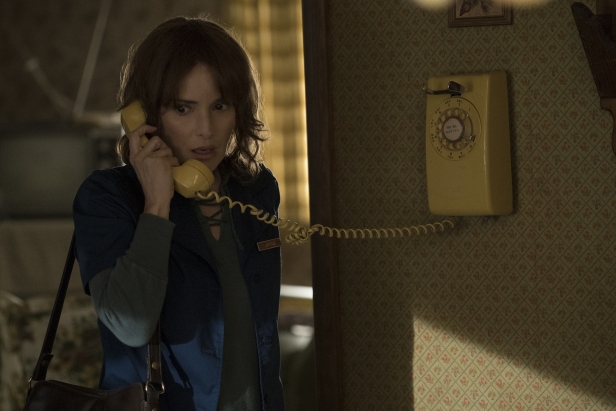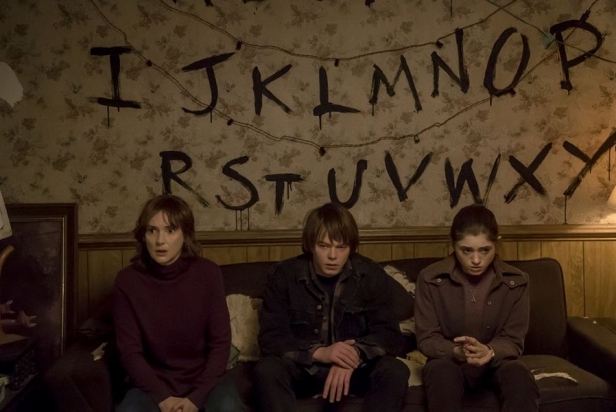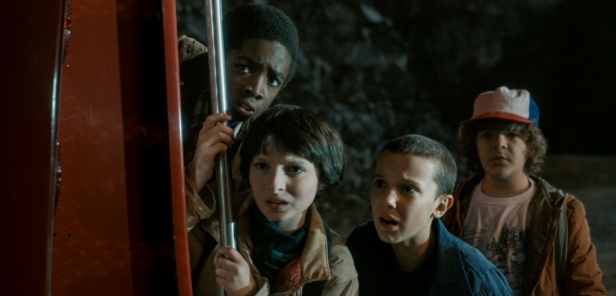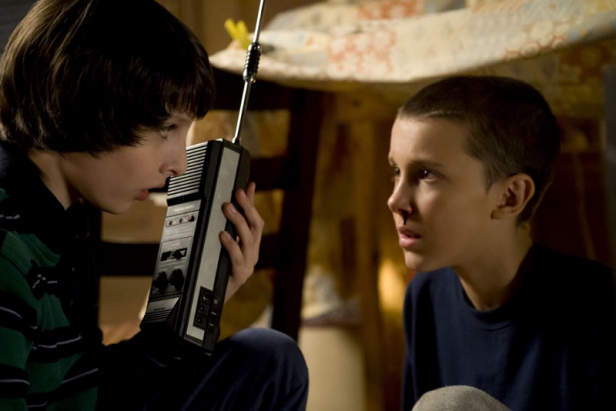The Duffer brothers’ supernatural drama Stranger Things hits Netflix today, and for fans of classic 1980s horror and sci-fi, it’s an absolute must-see. The show is set in 1983 and begins with the disappearance of young Will, who vanishes shortly after cycling home from a D&D session with his buddies. His mother (Winona Ryder) is frantic, the Sheriff (David Harbour) is at a loss, and his friends are determined to find out exactly what happened.
It soon becomes apparent that this is no ordinary missing person case. Wearing its influences on its sleeve, Stranger Things blends 1980s Spielberg, John Carpenter and Stephen King, giving us young kids with mysterious powers, a secret government testing facility…and a monster.
“I remember us talking about, if we could see anything on TV, what would it be?” Matt Duffer tells us. “And what we really wanted to see was something in the classic films we loved growing up. Like Spielberg stuff, John Carpenter stuff, and of course then the novels of Stephen King.”
We talked to the duo about their inspirations, why TV is a great place for horror, and why we all love Winona Ryder.
What is it about the genre films and books from this period that you love so much?
Matt Duffer: These stories are really mostly about ordinary people, people that we could relate to, dealing with extraordinary things. When we were growing up we had a relatively normal childhood, we were just playing Magic: The Gathering, Dungeons and Dragons with our friends, but when we watched these films or read these books, we felt transported, like suddenly our lives had the potential for adventure and I think that’s why these films and stories that we loved so much, that we wanted to try to capture that feeling again with the show. And that was really the genesis of the idea.
Was it always the plan to not just pay homage to that period, but to actually set it in the 1980s?
MD: We liked that about the ’80s, at the tail end of the Cold War, we liked the settting. This was around the time that it was believable to us that the government was conducting these shady experiments. Then of course you get all the benefits of the ’80s, there are no cellphones, no texting, so when the kids go out on their bikes looking for their friends they really are very much alone and anything could happen and they are in very real danger.
I think one of the things we liked about films with kids in them from that time, and anything Stephen King wrote with kids, was that those kids were never safe. There was something very real and scary and dangerous about the adventures that they went on. So that was important to us, that even with the kids the stakes stay really really high.
Ross Duffer: But at the same time, when we watched things like ET, not only did it hold up, with this certain timeless quality to it, there’s not a lot that feels super ’80s, it just feels like a classic fairytale. So while we are set in ’83 we didn’t want to be cute about it or shove it in peoples’ faces. We sort of hoped that, as you watch the show and get invested in the stories and the characters, it’s much more about being a story that could take place at any time and these characters could have existed at any time. More than it being a period piece.
There are three age groups in the show: the adults, the teenagers and the kids. Was it important to tell those distinct stories?
RD: I think when we were pitching it, and when you pitch you have to simplify a little bit, but we told them that we’d like to think of each of these generations as existing in a different ’80s universe.
So the adults are in a Spielberg film, they’re these imperfect individuals slowly but inevitably coming to realise that something very extraordinary is happening around them. And then the teens are in more of an 80s horror film like Halloween or Nightmare On Elm Street, where you’re juxtaposing the themes of high school, the loss of innocence, with a supernatural evil.
And then the kids are in a bit more of a Stephen King novel like Stand By Me or It, you have this group of nerdy kids who have to band together to face this terrifying evil. What we loved about having these eight hours is that we’re able to take all these different storylines that normally never co-exist in a single film and we’re trying to weave it all together. And it gives it a different feel.
MD: And at the same time, we wanted to tell stories of different generations, because the ultimate goal is that this is a show that can be embraced by everyone. We wanted there to be someone that everyone can relate to, so that’s why we wanted kids, teens and adults.
That was the great thing about Netflix, was that they embraced the idea that we could have a show that heavily features a bunch of 12 year olds but isn’t specifically geared towards kids, it’s for everyone. I think they got excited by that fact, it’s not something that television necessarily does, or movies for that matter. But certainly the stuff that we grew up loving like Stand By Me did exactly that and I don’t think that there’s enough entertainment like that in the world which is another reason why we wanted to write the show.
It is definitely very scary in places, but you are really invested in these characters.
RD: Well, that’s why we wanted to do the show on television. I think what’s tricky for us as genre fans, and being in the movie world for a little bit, is if you’re doing a horror movie, it really is now all about the jump scares. It’s almost like a haunted house ride, it’s like how many times can you get the audience to scream in an hour and half?
And that’s not why we liked horror films growing up. The ones that we really responded to when we were kids, like Rosemary’s Baby and The Shining and Jaws, they definitely were not about jump scares, they were equally as much about characters. When you go into a company like Netflix, it really feels so different compared to when you’re going into a film studio because they really care about characters. In fact they push you more in that direction than the other direction. They care much more about the characters than the monsters and the scares.
So it lent itself really naturally to what we wanted to do, and we were able to tell a story about these characters that also had a monster in it. That’s what all these filmmakers did. You look at Stephen King’s short story The Body, which isn’t a horror story at all, and then you put a monster in it, it becomes It. So it was important to us as we were writing it, that if we took out the monster and we took out everything supernatural, that it would still work and function as a show, so that was definitely something that we were mindful of. As fans of a particular type of movie and a genre it just felt like the only place to tell that story right now is on TV.
How difficult was it to find the right kids to play these roles?
MD: hat was really fun. We had an amazing casting director, Carmen Cuba, and we just cast an incredibly wide net. We were looking all over the world for these kids. The thing is that most kid actors are terrible. So you’re watching these auditions on tape and you can stop it after five seconds because you know. And what’s different about these kids is they felt very authentic to us and they felt like real kids. And they didn’t feel like or look like Nickelodeon kids.
People think that working with kids is difficult or challenging, but not if you find the right kids. They were amazing to work with. And they just get better and better over the course of the show because they’re learning as they’re working. It was the ultimate crash course for them in screen acting. I think by the end of the show they’re very professional actors, they’re fantastic. Millie Bobby Brown who plays Eleven is kind of like a 35 year old trapped in a 11 year old’s body, she feels so advanced already.
That role we were always really worried about because one of the things that kids are really not very good at is staying engaged in a scene when they don’t have dialogue. So being able to act when they’re not speaking, and that really is the Eleven role. She has so little dialogue. Millie’s able to do that. She’s able to not just function in that area, but kind of thrive in it. She’s just so incredibly talented so she felt like a real find for us.

I have to ask about Winona Ryder as well, it feels like a very different role for her and she’s fantastic!
MD: Winona was our first idea and we fell in love with it because we grew up in the late ’80s/early ’90s and we’re movie buffs, so we saw a lot of Winona Ryder films, and a bunch of her films, Beetlejuice, Edward Scissorhands, Little Women, were a big part of our VHS rotation. So we were big fans of her, and then when you’re casting a show, you want to cast someone who you feel, if you weren’t involved in a show, you would be excited to see and watch. And Winona is an actress who we felt we hadn’t seen nearly enough of lately. We were excited by the possibility of giving her a really good role and just to see her on screen again.
RD: And as fanboys to see her in the supernatural genre, which is our favourite Winona Ryder genre, that was exciting. She certainly hasn’t done anything like this in terms of being a mom before, I think that excited her, to do something that she hadn’t done before.
Stranger Things is now streaming on Netflix. Read more about the show in the new issue of SciFiNow.


